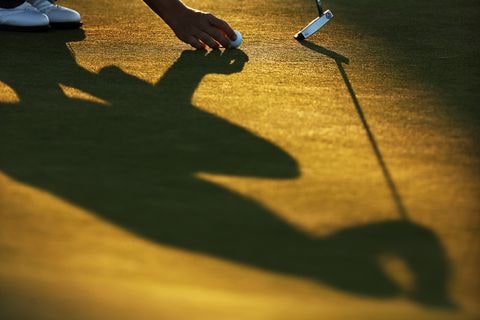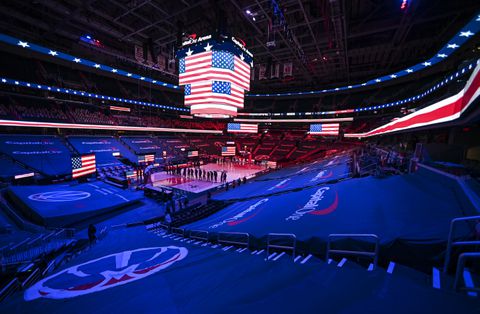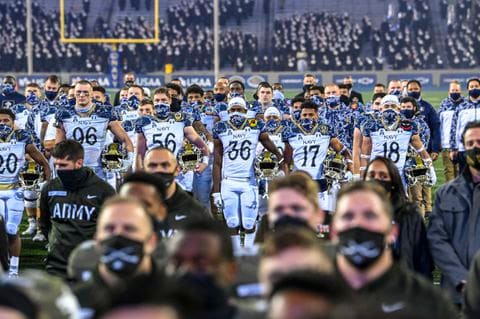The pandemic forced sports to make changes. These should stay.
When the world stopped a year ago, sports served as a crucial messenger in announcing everything had changed. The NBA halted its season when a player’s positive test returned minutes before tip-off, and in the coming days sports vanished from the calendar — March Madness canceled, the Olympics postponed, the baseball season in limbo. The missing thrills of games and cacophony of crowds paled in comparison to the tragedy wrought by the coronavirus, yet they still registered as losses.
Sports have crept back into our lives, mostly in vacant or partially filled arenas, in ways familiar and different. Box scores provide flickers of the old normal, and as fans return to stadium seats in the coming months, the games may begin to feel blessedly normal again.
But many of the changes the pandemic forced upon sports have also made them better. Here are the ones that should stay even after normalcy has returned.
— Adam Kilgore
 Golf’s U.S. Open was held in September. (Gregory Shamus/Getty Images)
Golf’s U.S. Open was held in September. (Gregory Shamus/Getty Images) A golf championship in the fall
PGA Tour golf was one of the first professional sports to return during the pandemic, and with it came a surprising wrinkle: The absence of galleries meant television viewers got a clearer view of what the courses actually look like because no fans lined the ropes. That’s not a practical solution, and the fans need to (and will) return, but it was kind of beautiful to see, say, Winged Foot in all its undisturbed glory during the U.S. Open.
Which brings us to what should stick around: That Winged Foot U.S. Open was held in mid-September. Wouldn’t it be nice to keep a major championship in the fall? Visually, it could be stunning, particularly if northern venues were used as the colors began to change. Plus, because the PGA Championship was moved to May, major championship golf is over in mid-July — four majors packed into a 16-week span. In a year without a Ryder Cup, golf cedes attention for six months. Moving the PGA Championship not back to its old home in August but into September or October would be brilliant.
— Barry Svrluga
Coaches wearing sweats, not suits
For decades, college basketball coaches have leaped on the sideline, screamed at officials and gathered with their sweaty players in perhaps the attire most ill-equipped for the moment: suits, ties, button-down shirts and dress shoes.
The pandemic has mostly suspended that tradition, possibly for good. These coaches are performing the same job as before, albeit in empty arenas, but many have embraced quarter-zip pullovers and polos. They wear casual slacks with sneakers. The women who lead programs have abandoned heels and blazers in favor of the same athletic gear. Suddenly their attire matches their job, which involves more erratic movement than a 9-to-5 office worker could imagine.
Even after game-day atmospheres and rowdy student sections return, the coaches’ formal attire doesn’t need to.
— Emily Giambalvo
Live-streamed high school games for all
When high school sports returned in recent months, empty bleachers were a given. After all, most schools were planning to hold winter athletics with limited attendance or no fans at all.
Before the pandemic, live-streaming high school events was a niche luxury available to a few local schools. Now, it has become the widespread standard. Almost every school in the Washington area currently holding high school sports provides a live stream of every event. Some are part of a larger pay-per-view service, while others are set up on sites such as YouTube and Facebook and run by students and teachers.
The response has been positive. Live streams give parents, students and community members a chance to tune in from afar or after hours. Even when they’re able to return to gyms, why not provide the option to watch from home?
— Michael Errigo
 Howie Kendrick got plenty of swings as the Nationals’ designated hitter. (Ricky Carioti/The Washington Post)
Howie Kendrick got plenty of swings as the Nationals’ designated hitter. (Ricky Carioti/The Washington Post) A permanent DH in the NL
During the shortened 2020 season, Major League Baseball eschewed decades of history and implemented the designated hitter in the National League. For the first time, pitchers were not required to hit for themselves, and NL teams had lineup spots for the kind of defensively challenged, offensively gifted players American League teams had been harboring for years.
MLB and the players’ union did not agree to implement a universal designated hitter again in 2021, though indications are that it will be atop the union’s priority list as the sides negotiate a new collective bargaining agreement this winter.
The change is needed; some pitchers who don’t have to hit at lower levels have their first at-bats in years come against major league pitching with finicky wooden bats — elevating injury risk and diminishing the chances of meaningful offensive contributions.
— Chelsea Janes
A virtual NFL draft for better TV
In April, there was doubt whether the NFL draft would even take place. But ESPN and the NFL figured out the logistical task of remote production for dozens of general managers, coaches and prospects who participated from their homes, and the show went on.
It was more than a technical feat, though; the intimacy of the draft and the windows into the lives of the players and coaches produced far better television than the overly glitzy affair held most years. Viewers got to see Dallas Cowboys owner Jerry Jones sitting on a white leather couch in his $250 million yacht, New England Patriots Coach Bill Belichick’s dog taking over his seat and Commissioner Roger Goodell announcing picks from his basement.
The in-person draft will almost certainly return, but it would be great if the remote format stuck.
— Ben Strauss
 A ball-tracking camera, used as an electronic line judge, keeps an eye on Bianca Andreescu at the Australian Open. (Paul Crock/Agence France-Presse/Getty Images)
A ball-tracking camera, used as an electronic line judge, keeps an eye on Bianca Andreescu at the Australian Open. (Paul Crock/Agence France-Presse/Getty Images) An end to line judges, and missed calls, in tennis
To safely stage the first Grand Slam of 2021 in a country that has all but eradicated the coronavirus, Australian Open officials limited spectators and eliminated linespeople.
With luck, once the pandemic ends, tennis fans will pack venues again. But line judges should not, now that exclusive electronic line-calling has been shown to work.
Hawk-Eye technology, in which computer-linked cameras track the trajectory of balls to determine their precise landing spot, has been used in limited fashion since 2006 but never as the sole arbiter of every line call in a major. There are arguments against its exclusive use — the technology is costly, and removing the human element could strip the sport of the theatrics created when players are convinced they’ve been wronged — but the arguments in favor are more compelling.
Electronic line-calling removes any question of bias, it expedites play, and, above all, it gets it right. Over the past two years, Hawk-Eye technology overturned 27 percent of challenged calls on the men’s pro tour, suggesting that on close calls linespeople err more than one in four times.
“No offense at all,” world No. 4 Dominic Thiem said at the Australian Open, “but there are just no mistakes happening, and that’s really good in my opinion.”
— Liz Clarke
Broadcasts that let fans hear what’s happening
Fans for the past year have been further removed from athletes and games and yet, in some ways, closer than ever. While fans could not watch in person, the silent arenas, courts, fields and courses allowed them to hear the games like never before, and it opened a new universe of insight into them.
The intensity of the NBA playoffs became more stark through the profane exchanges between players. Conversations between golfers and their caddies revealed how much mental gymnastics are applied to every swing. The clarity of a quarterback’s cadence allowed fans to understand NFL players are not only athletic marvels but expert linguists.
Broadcasters should keep and add as much intimate sound as possible, even after fans return and provide the familiar din. Players, coaches, caddies and referees should be mic’d. Announcers should learn when saying less means the viewer learns more. Producers should rely less on fans to tell the story of the games and more on the voices of the performers themselves.
— Adam Kilgore
 This season’s NBA and NHL schedules were built with less travel in mind. (Jonathan Newton /The Washington Post)
This season’s NBA and NHL schedules were built with less travel in mind. (Jonathan Newton /The Washington Post) ‘Series’ scheduling in the NBA and NHL
Needing to make up for billions of dollars in pandemic-related losses and to reengage with its local fan bases, the NBA is unlikely to permanently adopt a shortened schedule anytime soon.
But the league should continue to consider new initiatives that limit travel-related wear and tear whenever possible, as it has done with its baseball-like “series” model this season in which the same teams play each other in the same market in consecutive games. That new step has helped cut down on annoying one-game road trips and reduced the total miles traveled, and it’s a smart, simple fix that should stay once the schedule returns to 82 games.
Similarly, the NHL’s two-game sets should stay in place moving forward. The back-to-back games between teams were introduced to keep travel down in the NHL’s abbreviated 56-game season, and teams have welcomed the change. Beyond the travel benefits, players and coaches have said emotions from the first game of a pair can carry over to the second, creating more of a playofflike feel for regular season matchups.
And if NBA Commissioner Adam Silver wants to get ambitious, he should consider holding the Finals at a single-site location. Why travel across the country as many as four times for a seven-game series when the NBA could host a Super Bowl-like celebration for two weeks in Miami, Las Vegas, Paris or Beijing?
— Ben Golliver and Samantha Pell
Remote competitions — and coaching — for Olympic athletes
As people from all walks of life have leaned into their Internet connections and found ways to work and learn from home, the Olympic world has found similar success with online tools, especially with remote training and even virtual competitions.
For the nonelite athletes, many organizations can continue staging competitive events where the participants are spread across the country, connected and clocked with real-time technology. They might be on a stationary bike in their living room, hoisting barbells in a garage or charting long-distance runs with the Strava app.
Elite athletes unable to travel have still been able to access the country’s top coaches, who rely on apps and wearable technology to chart performance and create workout plans. The ability to coach from a distance gives a larger group of athletes access to better coaching.
— Rick Maese
Less offseason practice time for NFL players
The NFL got through last offseason and the 2020 season under far-from-normal conditions, and some of the most productive modifications related to the offseason. Teams conducted their offseason programs for players entirely virtually, with no on-field practices. Players were spared from year-round wear and tear on their bodies and the risk of injuries during practices conducted with the season months away.
There was no noticeable drop-off in the quality of play, and players and union leaders said the offseason should be adjusted accordingly moving forward. They’re right. Players don’t need to practice extensively year-round, especially with the NFL moving toward implementing a 17-game regular season this fall.
Coaches undoubtedly would complain, but the reduced offseason practice time should become the norm.
— Mark Maske
 Navy and Army met in West Point last season. (Jonathan Newton/The Washington Post)
Navy and Army met in West Point last season. (Jonathan Newton/The Washington Post) Temperature scans for college football players
Somehow, the country spent the first 150 years playing college football without developing a norm that might have prevented heaps of woe for coaches and, in turn, fanatics. Nobody — or, almost nobody — ever thought to take daily readings of players’ temperatures, even after the act of taking temperatures grew less onerous across human history.
“I tell you,” David Bailiff said in April 2020. “I sit here as a coach and think, ‘Why was I not taking my team’s temperatures during the flu season?’ ”
Through his coaching days at one high school and four Texas colleges (including Rice for 11 seasons and four rare bowl games, and Texas A&M Commerce at present), Bailiff had known those seemingly inevitable times when a flu might turn up, jump around the locker room and dent a season, especially with young male humans disinclined to report illness. “They don’t tell you … and they let it infect four or five of their buddies,” he said.
A potential solution turned up during, of all things, a pandemic.
— Chuck Culpepper
Keep the fairer World Cup selection process
Before the pandemic altered the 2022 World Cup qualifying calendar, the region known as Concacaf was not very inclusive. FIFA rankings would determine the six finalists, led by Mexico and the United States. Through round-robin play, three would punch tickets to Qatar and a fourth would enter a playoff against the tattered survivor of a regional, 29-country scramble. That winner would then enter an intercontinental tussle.
Good luck, Barbados.
Game cancellations caused seeding issues, though, so Concacaf altered the plan and unintentionally gave hope to smaller nations (and gave U.S. fans more consequential matches to watch). It’s fairer and in the spirit of the World Cup — and it should remain in place for World Cups to come. The giants will remain favorites, but at least the smaller sides will have a place at the table.
— Steven Goff






